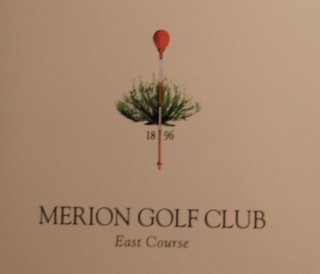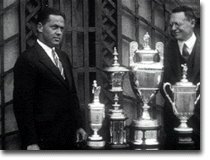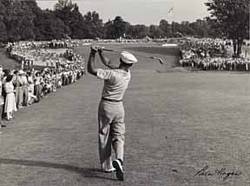It's not often that I re-post a course write-up. I got a chance to play Merion again earlier this year with my digital camera in tow and have posted some great new pictures with this new posting.
Shockingly, many of my readers inform me that they like my pictures more than my prose. Humbug.

Most major cities have their well-healed suburbs - in New York Greenwich and Darien. In Chicago, the communities along the North Shore of Lake Michigan. In Philadelphia, the affluent leafy suburbs are known as The Main Line. Named after the train line west of the city, the Main Line is old-world, understated, affluent and traditional. Merion is located in the heart of Philadelphia's Main Line and plays the part well. The land that the course and clubhouse are on trace their title back to William Penn.
Memory is not one of my strengths. One minute after meeting someone, I don't remember their name. Many times I have had to look at the bag tag of the member I'm playing with every three holes to remember his name and not make a complete fool of myself. And, I have gotten very good at not saying names. "Nice shot" instead of "Nice Shot, Dave", in case his name is in fact Bob.
There is, however, a part of my memory that works very well when it sees something memorable. I have found that the mark of a truly great course is how well you remember it both immediately after a round and six months later. Using this measure, Merion is a truly great course. After playing it once I could describe every hole in detail. The shape, terrain, bunkers, doglegs, green contours, etc. At Pebble Beach you sort of feel compelled to like the course because it is so pretty and everybody raves about. But, if you're being honest with yourself, aside from the eighteenth hole, can you visually remember all of the holes at Pebble? I'll bet you can't. Merion is seared into my memory. So far this has happened to me on only three courses in the world: Merion, The National Golf Links of America and Cruden Bay.

The 18th green as seen from the second floor locker room
What makes Merion so memorable? It is the ultimate strategic golf course. It is not a terribly long course. At Merion, you have to hit the fairways or it will be a long day. Second, you have to be on the correct side of every fairway in order to have a decent shot at the green. And finally, you have to be on the correct part of the green or you're in three putt territory. On every green. Also, the shot variety is really good as are the changes in direction, doglegs and uphill/downhill shots. No monotony here. As if the golf course itself is not good enough (and it is) you also have the grandeur and majesty of the white pillared clubhouse and the Bobby Jones and Ben Hogan history.

Bobby Jones with his grand slam trophies at Merion
If there was ever a course that new equipment risks destroying, it is Merion. It is too bad that the U.S.G.A and R. & A. have let the situation get out of hand and length is now the primary driver of competitive golf. It would be a shame if this course is lost from major competition forever.
I consider Merion to be the spiritual home of golf in the U.S. due to its greatness, its history, its association with Bobby Jones and the architecture of the course and the clubhouse. Merion's east course was designed in 1912 by Hugh Wilson, a Princeton graduate and captain of their golf team. The club traces its roots back to 1896 as you will see on the club's logo and evolved from the Merion Cricket Club.
This is the first course Bobby played a major on (the 1916 Amateur), the first course he won a major on (the 1924 Amateur) and the last course he played competitive golf on (the 1930 Amateur), completing the fourth leg of the Grand Slam at Merion in September 1930. Also, the classic photograph which is the golfing equivalent of the ironic shot of the sailor on V.J. Day kissing a woman in Times Square, was taken at Merion.

Ben Hogan on Merion's 18th hole at the 1950 U.S. Open
Taken by Life Magazine photographer, Hy Peskin, it shows Ben Hogan hitting a one iron on the eighteenth hole in the 1950 U.S. Open. It is an iconic picture of this great player at one of the most historic of courses in a perfect finish position. Hogan almost stopped playing during this final round because he was in such a state of fatigue recovering from a near fatal car accident the year before. Hogan hit the one iron onto the green and made a par to qualify for a three man playoff the next day which he would go on to win. It is one of the most heroic finishes of all time.

The short par three 13th hole as seen from the tee, shows off the Merion bunkers
Merion has many unique characteristics: the red wicker baskets as flags, the bunkers with clumps of grass in the middle (known as the white faces of Merion) and the scene around the first tee. You tee off right next to the outside patio with its green-and-white striped awning, with members and guests about five feet away from the tee box. It is one of the best opening holes in golf. The view in all directions is impressive; the clubhouse building with its white-washed stone and porch, the green awnings, the mature trees, the wicker baskets. The wicker baskets are red on the front nine and orange on the back nine.
Merion also still has what has unfortunately become a rare entity in American golf: Experienced caddies, and lots of them. The clubhouse, which is listed on the National Register of Historic Places is the golfing equivalent of St. Peter's. Also, like the Vatican, Merion upholds the traditional and the conservative in the game and in many ways is truer to the traditions than golf's governing bodies because they don't have to compromise with the equipment manufacturers. In addition to no pin flags, there are no yardage markers, no range finders allowed and no golf carts.
In the clubhouse and on the course at Merion you naturally speak in hushed tones and in a respectful manner. It sounds absurd but it is close to a religious experience.

Looking back from the first tee at Merion
Merion is also what I call a deceptively long short course. How about two par threes that can play more than 250 yards each? The third and seventeenth are long par threes with exceedingly difficult greens. Yes, the course has some short par threes and some short par fours but there are also some quite long holes mixed in. Part of the genius of architect Hugh Wilson was the mis-direction he used from the teeing grounds. The first hole is a good example as the tee point toward the left rough. The eleventh tee is pointed toward the right rough and the finishing hole directs the golfer toward the trees to the left of the fairway. Very subtle, but important. Most of Merion's greens are also set at an offset angle from the fairway, making the distance tough to judge and ensuring that missing the green is always in play.

The first tee as seen from the 18th green
No question it is one of the best opening holes in golf, along with Prestwick and The Old Course at St. Andrews. The tee box is located right next to the dark green awning next to the big tree. Since you are standing five feet from the membership having breakfast or lunch, it is a high pressure tee shot. How do you keep a short course relevant? Merion is a classic example of how. The fifth hole is a good example, a long par four with a stream all the way down the left side. This hole was designed along a side hill so the entire hole, fairway and especially the green slope from right to left. All but two perfectly struck balls will end up far left of your intended target.

The par five 4th green plays over a little brook and like many at Merion slopes back to front
The fourth hole (above) is a downhill par five that requires a precision shot, normally from a downhill lie, to a well bunkered green over a creek. Merion also features a half-dozen or so blind shots including this tee shot. The world-class eleventh also features a tee shot where you don't see your ball land either, as does the challenging sixteenth hole which begins the plan through the quarry.

The green on the short but tricky par four 7th hole

The green on the 11th hole, one of golf's most historic. Jones finished the grand slam on this green
When you play the eleventh hole, where Jones finished his match in the 1930 Amateur to win the Grand Slam, you have chills up and down your spine. I have, on the half dozen times I've been fortunate enough to play. Like most holes at Merion, there is just no margin for error on approach shots to the green. Dan Jenkins describes the shot into the eleventh green with absolute clarity as, "There is hardly any shot that will do except the perfect one." The hole is under 380 yards in length, so likely you will only be hitting a wedge, however, the combination of the small green, the water on three sides and the historic setting make it a nerve-wracking shot.
The 11th green has a myriad of hazards and a small, irregular shaped green. Hitting short into this bunker is no picnic
This shot of the 11th green from the side looking backward gives a good perspective on the narrowness of the green. One of the best examples of how to make a short hole difficult. Hugh Wilson was a master of his trade.

13th green - short par 3 near the clubhouse

16th "Quarry" hole approach to green. Better check your knickers.
The golfer is asked to this this fairway on the 16th hole. This view is from down in the valley and shows the narrow and winding nature of the fairway. From the tee, you can't see much except a few contours and outlines. And the tee shot is the easy one on this hole. The approach and putting shots are real testers.
The sixteenth, seventeenth and eighteenth play through an old quarry and are demanding finishing holes. After hitting a tee shot on sixteen to a snaking fairway that is not visible you face one of the most difficult shots on the course. There is a forced carry over the teeth of the old quarry to a diabolical green. The green is multi-tiered and slopes back to front. Being long when the pin is below you will mean an almost certain three putt. Seventeen is a long downhill, challenging par three. If there was such a thing as a par 3.5, this hole would be it. A par feels like a birdie. The drive on eighteen is back over the quarry. If you are lucky you will hit to where the famous plaque is where Hogan hit his famous one iron shot. Merion unquestionably has one of the best finishes of golf anywhere.

The sun setting on the 18th green
Nowhere are the white faces of Merion more of a hazard than on the 18th green. This dicey collection greets the golfer who has the misfortune of hitting short left. They are to be avoided at all costs as they are sure to lead to at least one missed stroke
Golf Digest editor Jerry Tarde described Merion as a three-act play: The Drama of the first six demanding holes; the Comedy of the next seven short, precision holes; and the Tragedy of the last five punishing holes. As the players in the 2013 U.S. Open found out, Merion still has teeth even as a 'short' course. The combination of canted fairways, subtle breaking and very fast greens, forced layups on many holes and an unheralded number of long holes mixed in continue to make it relevant. it was no surprise to me that the par four fifth hole which slopes from right-to-left the entire way, played so difficult. Only one player played it under par over four rounds. Also, no surprise that the finishing hole proved difficult. No player birdied it on Saturday or Sunday.
Merion is one of my personal top five places to play golf. If you get invited to play Merion, by all means make the pilgrimage.














































